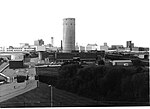Minet Country Park
Parks and open spaces in the London Borough of Hillingdon

Minet Country Park is a 36-hectare park on Springfield Road, Hayes in the London Borough of Hillingdon; it is situated between the A312 (Hayes by-pass) and the Uxbridge Road.
Excerpt from the Wikipedia article Minet Country Park (License: CC BY-SA 3.0, Authors, Images).Minet Country Park
Springfield Road, London Yeading (London Borough of Hillingdon)
Geographical coordinates (GPS) Address Nearby Places Show on map
Geographical coordinates (GPS)
| Latitude | Longitude |
|---|---|
| N 51.509166666667 ° | E -0.40222222222222 ° |
Address
Goals
Springfield Road
UB4 0LP London, Yeading (London Borough of Hillingdon)
England, United Kingdom
Open on Google Maps






